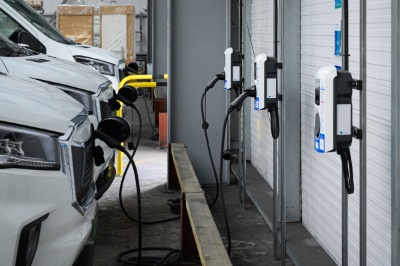HGVs and the road to electrification
 Giles Benbow, senior manager of business and partnership development at EV charging specialist Mer, looks at the challenges that fleet managers need to overcome
Giles Benbow, senior manager of business and partnership development at EV charging specialist Mer, looks at the challenges that fleet managers need to overcome
Most of the talk – and nearly all of the action – about the electrification of transport has been around cars. There are over a million on the UK’s roads now. Why don’t we hear more about the electrification of commercial vehicles?
Commercial vehicles haven’t had their share of airtime when it comes to the transition to electric transport. But electrifying commercial vehicles, lorries and vans will make a big impact on the things that are driving the EV transition: reducing greenhouse gas emissions, the need for cleaner air and decreasing the reliance on fossil fuels.
So, why the hesitance in moving ahead with transitioning commercial vehicles to electric? There are a lot of challenges involved, but it is by no means impossible. Fleet managers and transport operators need to feel confident that the challenges are being addressed across all areas of the industry, from vehicle manufacturers to the charging infrastructure.
Barrier one: it’s expensive
There is no hiding from the fact that cost is a major barrier to achieving the transition to electric commercial vehicles and HGVs. Commercial fleets are typically replaced every four to five years, which fleet managers and transport operators budget for. However, a battery electric truck costs on average two to three times more than its diesel equivalent.
Then there is the cost of power. Here, we don’t only mean the cost of the electricity itself, but also the cost of getting the electricity from the grid and into the battery. Public charging is expensive at the scale required to power a van or HGV. Similarly, the cost of installing an on-site charging infrastructure comprising charge point hardware, management software, cables, bays, etc. can be overwhelming.
Until there is parity in the cost of vehicles and a demonstrable return on the cost of installing an EV infrastructure, the total cost of operation, or ‘TCO’, is a significant barrier.
Barrier two: it’s disruptive
Another major challenge lies in the disruption involved in installing a charging infrastructure for a commercial fleet. Charging commercial vehicles – especially those with large payloads – is not simply a case of installing some chargers and plugging in a vehicle when it is back at the depot or charging at a public charge point on route.
A charging infrastructure sufficient for HGVs and LCVs can involve provisioning tens of megawatts of power. This process requires permissions and engineering work to secure multi-megawatt grid connections from the grid, which can take months or even years. The journey to upgrading the supply and bringing in new connections is complex and involves many variables. For most it’s a real step into the unknown.
The challenge for the EV charging industry is how to make the total cost and convenience of transitioning to electric commercial fleets attractive for transport operators.
EV charging companies have been exploring these challenges. The industry has consulted extensively with commercial fleet owners and operators, as well as bodies like the Road Haulage Association to arrive at innovative solutions than help make the transition affordable, accessible and sustainable for commercial and heavy goods EVs.
Solutions to the challenges are as varied and diverse as the challenges themselves, and we cannot deploy the same solution for every business – each solution should be devised based on the unique circumstances of each business, its fleet and the site we are installing EV charge points on.
They can include arrangements where the transport operator explores a build, own, operate model for an on-site charging infrastructure. Or a ‘charging as a service’ scenario, a kind of holistic outsourcing of the infrastructure and energy, where everything is optimised and controlled by an experienced EV mobility service provider.
Taking the first step
The starting point of any solution when electrifying commercial and heavy goods vehicles is a comprehensive analysis of what is available currently and what is required. That includes a full site-by-site investigation and analysis of where the business is looking to go in the future to allow for growth and accommodate advances in battery technology as they come on board.
This is where strong partnerships with experts delivers the ultimate return. After all, running a business or a commercial fleet is hard enough without having to become an expert in electrical infrastructure.
Electrifying commercial vehicles and HGVs involves provisioning a completely different way to fuel them without disrupting existing operations, as well as buying the new vehicles. Mer has the solutions to ensure this works for fleet owners and transport operators. And it all starts with a conversation.











